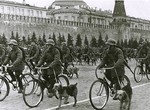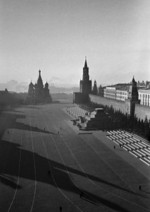Kremlin and Red Square
| Type | 174 Government Building | |
| Historical Name of Location | Moscow, Moscow, Russia | |
| Coordinates | 55.751667000, 37.617778000 |
Contributor: C. Peter Chen
ww2dbaseThe site of the Moscow Kremlin in Russia saw its first defensive structure (ie. usage of the Russian word grad) around the 11th century. It was destroyed during the Mongol conquest in 1237. In the 14th century, it was rebuilt, expanded, and strengthened, leading to it being named a major fortification (ie. kremlin). It served as the residence to several Tsars during the Tsarist and Empire periods. In 1918, the Soviet government relocated from Petrograd, Russia to Moscow, and the main government offices were housed in the Kremlin. Vladmir Lenin and Joseph Stalin also maintained personal quarters in the complex. It was during this early Soviet period that the Kremlin Wall Necropolis was established. Also around this time, several buildings, some dating back to the 16th-century, were demolished to make room for the military academy and the Palace of Congresses.
ww2dbaseDuring the reign of Ivan the Great, it was determined that the terrain east and northeast of the Kremlin created some disadvantage for the fortress' defenders, thus all buildings in the area were demolished in order to create a clear field of defensive fire. The newly open terrain would come to be known as the Moscow Red Square far before the use of red bricks in the area became commonplace and also far before the rise of the Soviet Union. Red Square served as the city's marketplace and its main place for official proclamations. The Cathedral of Intercession of the Virgin, commonly known as Saint Basil's Cathedral, which became integral to Red Square's identity, was completed in 1561. The square was paved in stone in 1804, and the moat that separated Kremlin and Red Square was filled in 1813. The Soviet military held regular parades at the Red Square soon after its founding. The two most important military parades at Red Square both took place during WW2. The first was the 7 Nov 1941 parade, which took place with German troops advancing on the city; it was used to bolster morale. The other was the victory parade after the end of the European war of WW2.
ww2dbaseThe Grand Kremlin Palace served as the official residence of the President of the Russian Federation since its founding as the successor state to the Russian Soviet Federative Socialist Republic.
ww2dbaseSource: Wikipedia
Last Major Update: Aug 2017
Kremlin and Red Square Mapa Interativo
Photographs
 |  |  |  |
Kremlin and Red Square Timeline
| 12 mar 1918 | The Soviet government relocated from Petrograd to Moscow in Russia. Many of the government offices were housed in the Moscow Kremlin. Vladmir Lenin and Joseph Stalin also maintained personal quarters in the complex. |
| 6 jun 1940 | The Kremlin issued an ultimatum to Latvia, demanding it the allow Soviet occupation. |
| 1 jul 1941 | Joseph Stalin returned to the Kremlin in Moscow, Russia as Chairman of the new State Defence Committee, set up by law the day before. |
| 26 jul 1941 | German aircraft bombed Moscow, Russia. Many bombs fell near the Kremlin, and the images were captured on film by journalist Margaret Bourke-White. |
| 4 dez 1941 | At an event at the Kremlin in Moscow, Russia, Joseph Stalin noted to Aleksandr Vasilevsky his surprise that Vasilevsky only had a single Order of the Red Star and a medal on Vasilevsky's uniform; the Soviet leader had expected the general to be better decorated. |
| 12 ago 1942 | Winston Churchill arrived at Moscow, Russia at 1700 hours. At 1900 hours, he met with Joseph Stalin for the first time at the Kremlin, among other things convincing him there would be no second front at least until 1943 as the Western Allies would soon be invading French North Africa. |
| 1 nov 1943 | At a dinner at the Kremlin in Moscow, Russia, Joseph Stalin told Cordell Hull that the Soviet Union would be willing to engage Japan in a war after Germany was defeated. |
| 24 jun 1945 | Konstantin Rokossovsky commanded a victory parade at the Red Square in Moscow, Russia. |
| 14 abr 1961 | Nikolai Kamanin accompanied Yuri Gagarin in a parade in Gagarin's honor in Red Square, Moscow, Russia. |
Você gostou deste artigo ou achou este artigo útil? Se sim, considere nos apoiar no Patreon. Qualquer valor já vai ajudar! Obrigado. Por favor, ajude-nos a divulgar o site: Fique atualizado com WW2DB: |

Moscow, Moscow, Russia
Latitude-Longitude:
55.7517, 37.6178
- » 1,181 biografias
- » 337 eventos
- » 45,111 entradas na linha do tempo
- » 1,247 navios
- » 350 modelos de aeronaves
- » 207 modelos de veículos
- » 376 modelos de armas
- » 123 documentos históricos
- » 261 instalações
- » 470 eventos
- » 28,476 fotos
- » 365 mapas
Lt. Gen. Lewis B. "Chesty" Puller, at Guadalcanal
Por favor, considere nos apoiar no Patreon. Mesmo R$1 por mês já faz uma grande diferença. Obrigado!
Ou, por favor, nos apoie adquirindo alguns produtos do WW2DB na TeeSpring. Obrigado!